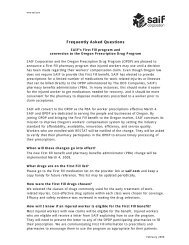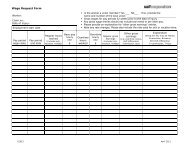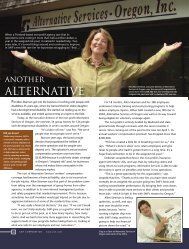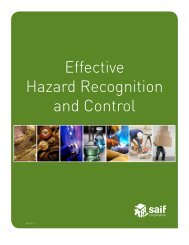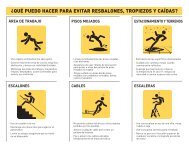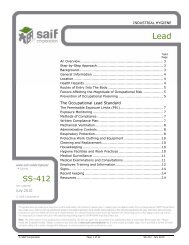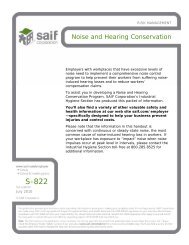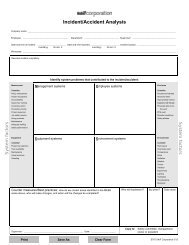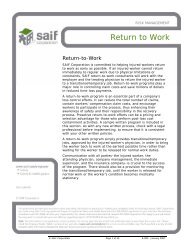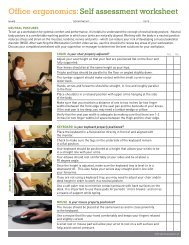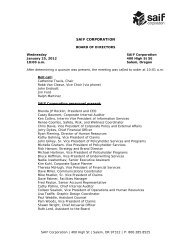pg. 6 - SAIF Corporation
pg. 6 - SAIF Corporation
pg. 6 - SAIF Corporation
Create successful ePaper yourself
Turn your PDF publications into a flip-book with our unique Google optimized e-Paper software.
Features<br />
Written by Judi Croft {<strong>SAIF</strong> Safety Consultant Training Supervisor} and Al Polito {<strong>SAIF</strong> Publications Editor}<br />
16 CN Fall 2008<br />
Putting employees first starts with putting safety first<br />
In a time when smart employers are taking<br />
unprecedented measures to lure a workforce that<br />
regards corporate values alongside salary amount,<br />
successful companies are promoting workplace<br />
safety to demonstrate commitment to their workers.<br />
Employees who know that their well-being is a<br />
priority are more likely to provide years of service to<br />
their employers.<br />
>><br />
Ask the right questions<br />
Improving your work<br />
environment begins with<br />
asking the right questions.<br />
Some important ones to<br />
ask are:<br />
• What is our greatest<br />
operational challenge<br />
right now<br />
><br />
• What are employees<br />
complaining about<br />
• How are people getting hurt<br />
• What shortcuts do employees<br />
take that get them into trouble<br />
Often, the answers are not, in<br />
fact, “under your nose,” but can<br />
be found in other industries that<br />
have the same challenges as you<br />
do. By asking the right questions,<br />
and then paying attention to how<br />
others solve the problem, you can<br />
transform your work environment.<br />
Following are some examples of<br />
technologies developed for one<br />
industry that can be life-savers for<br />
a different industry.<br />
The cost of not committing to a truly safe working<br />
environment isn’t apparent until your best employees<br />
leave to work for your competitors, or worse, until an<br />
injury takes place that impacts human lives.<br />
But if you’re like most employers, you keep the<br />
floors dry and use common sense to make sure your<br />
employees are safe. What more can you do to make<br />
your work environment an asset that actually attracts<br />
and retains talented employees<br />
Breakaway Stirrups<br />
Ranchers on horseback place great trust in their<br />
equine companions, but every once in a while<br />
even a highly trained horse gets spooked and<br />
throws its rider. With his or her foot stuck in a<br />
stirrup, a rider can be dragged, pinned beneath<br />
a falling horse, badly kicked, or stepped on.<br />
Injuries may include ruptured organs, brain or spinal cord damage,<br />
and crushed or broken bones. Claims to <strong>SAIF</strong> have exceeded $50,000<br />
for these types of injuries.<br />
Unlike cattle ranchers, however, rodeo riders count on getting thrown<br />
from their mounts on a daily basis. To minimize the risk of injury, they<br />
have begun to use safety stirrups such as STI’s Breakaway Stirrups. As a<br />
rider gets thrown, the stirrup detaches from the saddle and allows him<br />
or her to land far enough from the horse to escape the worst injury.<br />
Cattle ranchers are now beginning to use Breakaway Stirrups; the cost<br />
of a workers’ compensation claim in a horse-related injury frequently<br />
exceeds the most expensive pair of stirrups, priced around $500.<br />
Many riders who have been thrown while using this equipment have<br />
written the company thanking them for saving life or limb.<br />
From people to pets<br />
Moving an ailing Chihuahua from the front desk of the<br />
veterinary office to the operating table may not pose a<br />
problem for the front desk nurse, but what if the patient<br />
were a more substantial breed, such as an English<br />
Mastiff, St. Bernard, or Great Dane Approaching or<br />
exceeding 200 lbs., these dogs are big enough to cause<br />
back strains or other injuries during transport.<br />
Some veterinarians have begun to adopt human hospital<br />
technology to prevent injury to both people and pets.<br />
“Danger is part of this work”<br />
This idea is another example<br />
of “hazardous thinking” that<br />
leads to unsafe behavior. Even<br />
stunt men and women, who<br />
put themselves in the path of danger on a<br />
daily basis, take every imaginable precaution<br />
to ensure their safety, so that they may return<br />
to work another day.<br />
Replacing that notion with “Safety is part of<br />
this work” involves making every safety option<br />
available to your employees and rewarding<br />
them for taking the time and effort to use<br />
them. Nearly every workplace injury can<br />
be avoided if employees feel empowered,<br />
encouraged, and unrushed about taking<br />
proper safety measures.<br />
To change a light bulb<br />
When a light bulb goes out in a<br />
building with a high ceiling, such as a<br />
warehouse, factory, or even a church,<br />
maintenance personnel often use<br />
extension ladders to access the socket and replace<br />
the bulb. Ironically, most injuries from this approach<br />
result from moving the ladders rather than falling from<br />
them, although falling is definitely a danger.<br />
Cherry pickers or scissor lifts are beginning to<br />
replace dangerous extension ladders. Formerly the<br />
domain of cherry harvesters and construction crews,<br />
these aerial work platforms, as they’re also known,<br />
are a safe alternative and often exceed the vertical<br />
reach of extension ladders. They can be rented,<br />
leased, or purchased.<br />
Besides changing light bulbs, aerial work platforms<br />
increase safety for tasks such as window washing,<br />
electrical work, and even decorating large structures.<br />
Hospitals have developed special ceiling-mounted<br />
and portable lifts that are used to move incapacitated<br />
patients – especially the elderly – safely to their beds<br />
from either a seated or even lying down position. By<br />
fitting a sling around the patient, office personnel<br />
can transport a human-sized beast right up onto the<br />
operating table without exerting much strength.<br />
Hazardous thinking leads<br />
to hazardous behavior<br />
In their rush to get things done quickly, workers<br />
often take shortcuts. However, many workers’<br />
compensation claims are the result of shortcuts<br />
gone awry. Common thinking that leads to<br />
problems, and therefore injuries, includes:<br />
“I don’t have the time<br />
to do this the way<br />
they say I should.”<br />
“I didn’t realize a safer<br />
option was available.”<br />
“This item is<br />
cumbersome<br />
or awkward.”<br />
“The right tool isn’t located<br />
where I need it, so I’ll use<br />
something else.”<br />
Employers need to combat the temptation to<br />
take shortcuts. Ways to do this include:<br />
• Not penalizing employees for taking the<br />
time they need to do the job right or asking<br />
someone to help them<br />
• Making sure items like step stools, gloves, or<br />
goggles are readily available wherever they<br />
might be needed<br />
• Using products designed to enhance<br />
workplace safety, including furniture sliders<br />
and lifting aids like dollies and carts<br />
• Educating your employees about the safety<br />
items available to them, and the protocols for<br />
maintaining a hazard-free work environment<br />
By eliminating the temptation to take shortcuts,<br />
employers demonstrate to their staff that, in fact,<br />
their employees come first. When workers know<br />
that they are valued, they increase their loyalty<br />
to their employer.<br />
Fall 2008 CN 17



